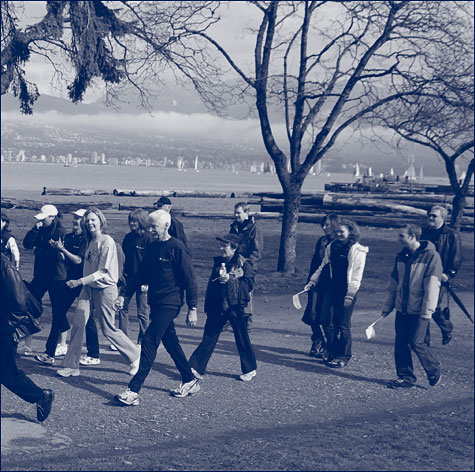version (PDF)
| Printer-friendly version (PDF) |
|
|||||||||||||||||||||||||||||||||||||||||||||||||||||||||||||||||||||||||||||||||||||||||||||||||||
STRATEGIC PLAN UPDATE
|
|||||||||||||||||||||||||||||||||||||||||||||||||||||||||||||||||||||||||||||||||||||||||||||||||||
| 1 | Make British Columbia the best-educated, most literate jurisdiction on the continent. |
| 2 | Lead the way in North America in healthy living and physical fitness. |
| 3 | Build the best system of support in Canada for persons with disabilities, those with special needs, children at risk, and seniors. |
| 4 | Lead the world in sustainable environmental management, with the best air and water quality, and the best fisheries management, bar none. |
| 5 | Create more jobs per capita than anywhere else in Canada. |
It will take hard work and dedication from all of us to unleash British Columbia's unlimited potential and achieve our Five Great Goals. It will also take the leadership and dedication of the public service, whose commitment to excellence and dedication has been instrumental in the accomplishment of B.C.'s outstanding achievements.
I am confident that, working together, we will succeed and together we will create a Golden Decade for all British Columbians.
Gordon Campbell
PREMIER

The purpose of the Government Strategic Plan is to inform the public and the public service of the strategic direction that government will pursue while working closely with its citizens and partners.
It describes government's goals — what government aims to accomplish and the process by which government will develop strategies and actions to achieve these goals.
Greater detail on how this strategic direction will be implemented will be reported to British Columbians through the service plans and annual service plan reports of each ministry and Crown agency.
Government's Strategic Plan will guide all planning and reporting activities undertaken across the public sector.
Our vision for B.C. is:
To be a prosperous and just province, whose citizens achieve their potential and have confidence in the future.
Government's core values are:
In determining the goals for the next ten years, government reflected on what has been accomplished to date and what needs to be done in the future. From 2001/02 to 2004/05, the Government Strategic Plan identified the following three goals:
The government's Five Great Goals build on the foundation of the three original goals. Successfully achieving the Five Great Goals is dependent on maintaining a vibrant economy, a supportive social fabric, and a sustainable environment.
For example, as part of maintaining a vibrant economy, government has an ongoing commitment to be affordable and fiscally responsible. Over the past four years, government established a stable and sustainable fiscal position and government's financial reporting now fully conforms to generally accepted accounting principles. This has been accompanied by a re-energized B.C. economy and reinforced consumer and investor confidence. Government will continue its commitment to affordability and fiscal responsibility, while making investments that create new opportunities, foster economic growth and support B.C. to achieve its Five Great Goals.

For 2005/06 to 2015/16, government will focus its energy on achieving the Five Great Goals. The goals are to:
| 1 | Make British Columbia the best-educated, most literate jurisdiction on the continent. |
| 2 | Lead the way in North America in healthy living and physical fitness. |
| 3 | Build the best system of support in Canada for persons with disabilities, those with special needs, children at risk, and seniors. |
| 4 | Lead the world in sustainable environmental management, with the best air and water quality, and the best fisheries management, bar none. |
| 5 | Create more jobs per capita than anywhere else in Canada. |

All ministries and Crown agencies have a role to play in achieving the Five Great Goals. For some, it may take the form of implementing specific programs, initiatives or strategies. For others it will mean remaining focused on creating the strong and vibrant economic results that facilitate government actions.
To successfully achieve the Five Great Goals, government must define strategies and measure progress. This means that performance measures and targets must be developed. It is also important to ensure that the performance measures used are correct, as opposed to simply being "available". It is counter-productive to work to achieve targets that are not considered by British Columbians as true indicators of success. Careful thought, consideration of a variety of perspectives, and adequate time for refinement of performance measures and targets is required.
The focus of this strategic plan update is therefore to ensure that the transition to the Five Great Goals proceeds, the goals themselves are clearly explained, and the process for finalizing performance measures and targets prior to the release of government's 2006/07 – 2008/09 service plans is well underway. Some of the work that is already in progress to achieve the Five Great Goals is highlighted in the detailed discussion of each goal.
By taking the time now to ensure the integrity and appropriateness of each performance and target measure it will also be possible to build better linkages between the overall government strategic plan and individual ministry service plans, thus strengthening the service planning process overall. The 2006/07 – 2008/09 government strategic plan, that will be publicly released in February 2006, will detail the following:
Achieving each target will depend on a collaborative approach involving the actions of multiple ministries and/or Crown agencies, and all British Columbians.
Ministries and Crown agencies have already been considering what actions they need to undertake over the next three years to contribute to achieving the Five Great Goals. These will be outlined in ministry and Crown agency service plans.
1 Literacy BC
Education and skills are critical to succeed in today's rapidly changing, global, knowledge-based economy. Skills such as reading, writing and numeracy are the foundation skills for lifelong learning and success in a knowledge-based economy.
Education, literacy and training, are crucial to individual and societal competitiveness, and along with research and innovation, contribute to an overall higher level of economic and social wellbeing. For these reasons, government has set a goal to make B.C. the best educated, most literate jurisdiction on the continent.
Education is a top priority for government and has been for the past four years. Some initiatives that are already underway to support this goal include:
Government will focus on priority areas such as:
A potential performance measure is the International Student Assessment (PISA) which assesses internationally the achievement of 15 year olds in reading, science and math. The latest 2003 PISA score for reading shows that 75% of B.C. students scored Level 3 or higher. This means that students are capable of reading tasks of moderate complexity, such as locating multiple pieces of information, making links between different parts of a text and relating it to familiar everyday knowledge. British Columbians could set a target to increase the proportion of students who perform at internationally recognized levels of literacy.
In order to achieve this goal, government must collaborate with its key partners to ensure that we all progress, monitor and respond to changes and trends. Key partners relating to this goal include school boards, schools, post-secondary institutions, early childhood educators, the child care sector, the private post-secondary education sector, the research community, industry, educators, parents, families, federal government departments (such as the Department of Human Resources and Skills Development and Citizenship and Immigration Canada) and above all, lifelong learners.
Conditions or trends that may affect the achievement of this goal include changing economic conditions, an aging population, shifting demographic trends, inflow of immigrants, and level of support from the federal government.
2 Canadian Cancer Society
Nothing is more important to the quality of living and lifestyle in B.C. than our health. Good health is critical to wellbeing because it enables people to enjoy their lives to the fullest, take advantage of education and employment opportunities, and participate fully in society and the economy. Health can also have a cumulative effect on life outcomes — poor child health is linked to poor adult health and also to broader poor outcomes including unemployment and crime. Improving the health and physical fitness of British Columbians can help protect the public from preventable disease, illness and injury and keep the province's public health system sustainable into the future.
Health care is one of the most important issues for British Columbians, and government has made health care a top priority. A few of government's accomplishments of the past four years include:
To lead the way in North America in healthy living and physical fitness, it is important that British Columbians make positive lifestyle choices and are active. Appropriate performance measures to assess the health and fitness of British Columbians will be discussed with government's partners in this area.
Other priority areas for this goal are:
To achieve this goal, government will build on past accomplishments, continue with and create new partnerships, and monitor and respond to changes and trends. Key partners relating to this goal include health authorities and health care providers, the non-profit community, school districts, schools, community organizations, municipalities, the sport and recreation system, and federal government agencies (such as Health Canada, and the Public Health Agency of Canada).
While British Columbians currently enjoy the best health status in Canada, there are worrying trends which may affect the achievement of this goal and create unprecedented demands on the health care system. Examples of these trends include the fact that 42% of adult British Columbians are overweight or obese according to self-reported data, and only 58% are physically active or moderately active. In addition, an aging population with rising rates of chronic illness is resulting in the continuing increase in demand for complex and expensive health care services.
3 Statistics Canada. A Profile of Disability in Canada, 2001 — Tables. December 2002
4 Waddell, C. & Shepherd, C. Prevalence of Mental Disorders in Children and Youth — A Research Update Prepared for the British Columbia Ministry of Children and Family Development. Mental Health Evaluation and Community Consultation Unit, UBC. 2002
British Columbians have one of the highest levels of overall health and wellness in Canada. However, some population groups, such as people with disabilities, children and youth with special needs, children and youth at risk, people with mental health disorders, addictions or problematic substance use, and seniors face multiple barriers to improving their social and economic wellbeing. Overcoming these barriers requires focused interventions that are integrated and client-centred.
To create the best system of support government will build on a number of significant programs and initiatives that are already underway, including:
Ensuring that appropriate actions are in place to achieve this goal is a challenge. Government wants to:
To achieve this goal, government must collaborate with its partners and understand and respond to trends. Key partners include health authorities and health care providers, schools, non-profit organizations, community organizations, police judiciary and the legal community, First Nations, provincial and territorial governments, and federal government agencies (such as the Canada Mortgage and Housing Corporation, Human Resources and Skills Development Canada, Health Canada, Justice Canada, and Indian and Northern Affairs Canada).
Examples of trends related to this goal include an aging population, demographics, expanding health care services, advancements in health and other technology, pharmaceutical advancements, increasing drug costs, rising housing costs, growing homelessness numbers, and criminal and justice laws of other governments.
5 Statistics Canada. Human Activity and the Environment — Annual Statistics 2004
To support a healthy environment, government will foster sustainable environmental management: sound environmental practices that support human health and foster economic and social objectives today and for the benefit of future generations.
The provincial government will build on its demonstrated success in managing and protecting B.C.'s natural environment, including:
These accomplishments illustrate government's strong commitment to building B.C.'s environmental legacy. However, more must be done to ensure this legacy is maintained for future generations.
6 Morice, North Coast, Central Coast, Lillooet, Haida Gwaii and Sea to Sky
In order to be able to advance this goal, objectives will be developed in areas such as:
Potential performance measures for this goal include a "trends in water quality" measure developed as part of the Canada-B.C. Water Quality Monitoring Agreement, and a measure of airborne fine particulate concentrations for selected B.C. communities.
To achieve this goal, government will collaborate with key partners including community organizations, the non-profit community, First Nations, schools, post-secondary institutions, industry, professional organizations, and federal government agencies (such as Environment Canada, Natural Resources Canada, Indian and Northern Affairs Canada, Transport Canada, Statistics Canada and Fisheries and Oceans Canada).
Trends that will influence our success include the economic outlook for the province and nation, the value of the Canadian dollar, global market forces, advancing technology, rapid population growth, demographic shifts, changing consumer choices, the Kyoto Protocol, and support from other levels of government.
7 Finlayson, J. & Peacock, K. Mid-Year Economic Review: British Columbia On Track for Solid Growth Through 2006. Business Council of British Columbia, 2005
Virtually every sector in British Columbia is now buoyed by B.C.'s new confidence and competitiveness. This has helped to facilitate an environment throughout the province that builds confidence and creates jobs.
Government will build on its successes to improve British Columbia's jobs per capita performance relative to the rest of Canada. Other priority areas related to this goal include:
To achieve this goal, government will collaborate with its key partners and respond to changing trends. Key external partners include the business community, investors, industry, First Nations, labour unions, local governments, and federal government agencies (such as Industry Canada, Foreign Affairs Canada, Labour and Housing, Department of Human Resources and Skills Development, and Indian and Northern Affairs Canada).
Examples of changes and trends relating to this goal include the economic outlook for the province and nation as well as B.C.'s major trading partners, value of the Canadian dollar, commodity prices, population and demographic shifts, skills shortages, and the ability to attract skilled immigrants.

For B.C. to fully realize its Five Great Goals, government recognizes that it is not enough to identify goals and implement strategies to achieve them. It must also identify and ensure conditions for success.
In order to accomplish the Five Great Goals, government believes that:
Government recognizes that the historical Aboriginal-Crown relationship in B.C. has given rise to the present socio-economic disparity between Aboriginal people and other British Columbians. Government has committed to work with First Nations to ensure that the five goals for improving health, education, support services, environmental management and job creation are realized in First Nation communities. The province will work collaboratively with First Nation governing organizations to achieve these goals together.
Real progress requires a new relationship founded on reconciliation, recognition and respect for Aboriginal rights and title. This will be a cross-government priority as we establish new working partnerships with First Nations to achieve our mutual goals.
Government and First Nations agree that having First Nations as a strong economic partner in the province and country through sustainable land and resource development, through shared decision-making and benefits, will support First Nations as healthy, working communities. This relationship will benefit all British Columbians and lead to long-term economic viability.
The province is meeting in an unprecedented collaboration with B.C.'s First Nations' leadership to design a work plan with social and economic indicators that will allow us to measure progress toward the results we need. Our joint objectives and actions will be informed by the needs of First Nations people in urban areas, as well as those working to finalize treaties and lasting agreements for land, resources and governance.

To better meet the diverse needs of British Columbians, government will improve the delivery of public services to make them more accessible, easier to deal with and more responsive to individuals and communities. Whether a family member is arranging support for an aging relative, a parent is accessing services for a child with special needs, or a wilderness recreation guide requires a permit, they should not have to be an expert on government organizational structure to get all the information and services they are looking for.
This is a significant and long-term undertaking. It requires government to adopt a citizen-centred approach to the design and delivery of public services. In order to do so, government will coordinate across ministries and agencies so that information and services are packaged and presented in a way that is timely, easy to understand and simple to use. One new citizen-centred service delivery initiative is a new single point of contact or "single window" Natural Resource Opportunities Centre located in Kamloops for clients seeking natural resource permits and licences.
Expanding the Asia Pacific gateway infrastructure and strengthening relationships with the rapidly growing economies in Asia will allow British Columbia to realize trade, tourism and cultural opportunities. Government is committed to strengthening and developing trade relationships with Asia Pacific countries. To facilitate trade partnerships government will also develop inter-modal transportation links and transportation infrastructure designed to help augment British Columbia's position as the Canadian gateway for the Asia Pacific market. In addition, government is committed to developing other types of Asia Pacific infrastructure including cultural exchange opportunities, education and skills partnerships, and together with the federal government, immigration and international commerce linkages.

The 2010 Olympic and Paralympic Winter Games are a once-in-a-lifetime opportunity for British Columbia to showcase the province on a global basis, to celebrate provincial accomplishments and to create lasting economic opportunities for British Columbians. Government is committed to ensuring businesses throughout the province are prepared to take advantage of 2010 Games opportunities.
ActNow BC will assist British Columbians to make positive lifestyle choices, be active, and enjoy the good health they need to allow them to fully participate in society. Through ActNow BC, government will promote physical activity, healthy eating, living tobacco free and making healthy choices during pregnancy. Government will also focus on improving Aboriginal health and wellness by supporting a National Aboriginal Health Blueprint to resolve jurisdictional conflicts, and developing innovative health programs such as tele-health programs in Aboriginal communities.
The B.C. public service is vital to making government's goals a reality. In order to reinvest in its public service government will continue to build on its leadership training initiatives started in the last four years, and step up its efforts related to succession planning, increasing the diversity of the public service, and the work experiences that staff is able to take advantage of.

Over the last four years British Columbia has accomplished a tremendous amount, and has moved closer to government's long-term vision of British Columbia as a prosperous and just province, whose citizens achieve their potential and have confidence in the future.
British Columbia has strengthened its social, economic, environmental and fiscal foundations. Maintaining this foundation remains a priority, as government and British Columbians strive to meet the Five Great Goals.
There are many exciting opportunities for action to achieve the Five Great Goals. Our performance measure for the remainder of 2005/06 will be to consult with British Columbians to develop a suite of measures through which our success in achieving the Five Great Goals can be assessed. When government releases its strategic plan in February of 2006 specific actions, and those performance measures and targets to assess progress that have been developed with the input of stakeholders, will be in place. Each year the strategic plan will be reviewed to assess progress against targets and the effectiveness of specific actions. The plan will be updated as required.
Accomplishing the Five Great Goals will require considerable effort on the part of government and British Columbians. Working together and building strong relationships will be essential for success. This means that progress on First Nations reconciliation and Aboriginal well being will be a priority.
While there is much to do, there is already much to celebrate, and much to look forward to as well. By working hard to achieve the Five Great Goals, and by taking time along the way to celebrate what has been accomplished, British Columbians will be able to create a Golden Decade for British Columbia.

|
|
|
|
||||
|
|
||||
|
|
|
|
|
|
|
|
||||